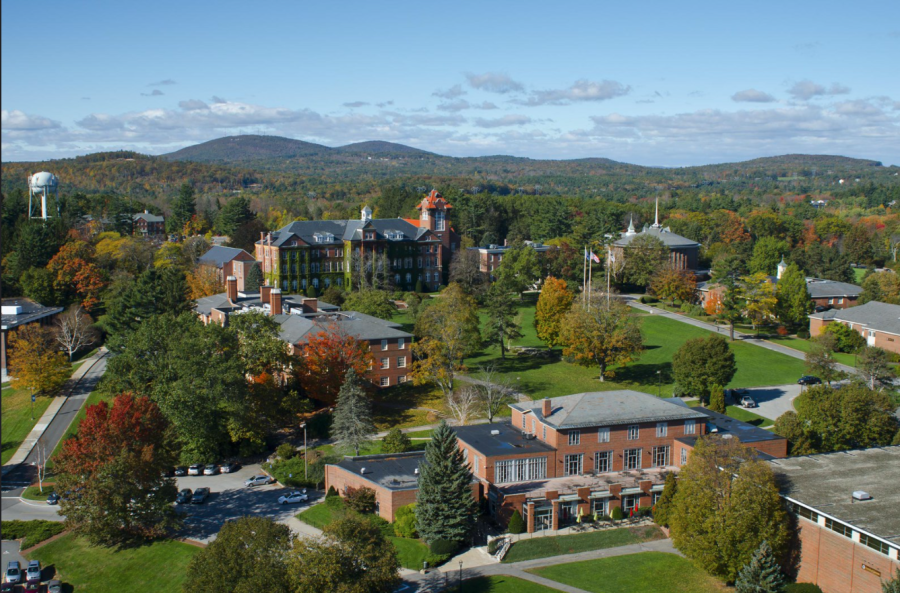Saint A’s battles Omicron surge in Northeast
Aerial view of the Saint Anselm College Campus
February 11, 2022
As the college prepares for another New England winter, students at Saint Anselm are eager to move towards an era of post-COVID normalcy. A collective desire to return to a reality without the threat of coronavirus remains, as students wield their makeshift “sleds” (i.e. trays), from Davison Hall onto the fresh blanket of snow. However, a pervading atmosphere of uncertainty and apprehension looms above returning students and staff alike, especially as the recent Omicron variant of the virus surges across the nation.
According to the CDC, as of Sunday, national COVID-19 cases have taken a brief downward turn; in narrowing the scope closer to our campus in New Hampshire, health experts in Hillsborough county reported positivity rates at 19.28 percent in the last seven days. The community transmission rate is classified as high at the current time.
Following the closure of the Fall semester, Director of Health Services Maura Marshall lamented a “widespread COVID crisis in New Hampshire,” prompting “the National Guard and FEMA to help our state’s health care workers” as of December 17 of 2021. Marshall carefully outlined the necessity for an increased campus immunity rate, citing CDC recommendations that vaccines had proven to become “less effective after six months.” After nearly 3 and a half months on campus, the campus immunity rate had fallen to a mere 28 percent by mid-December.
As for the current semester, Marshall praises the success of COVID-19 protocols. “COVID does not have a season yet, so winter should not have an impact except that more activities are inside,” she writes. “What is going to help us stay ahead of managing COVID on campus is that students are able to go home to isolate because more families are vaccinated and have a plan in place if someone tests positive,” which will consolidate the amount of isolation space for students further from home. Marshall concludes by adding that “students have not been as sick or hospitalized with the latest variant,” a large improvement since last Spring. Protocols have ultimately shifted as students and faculty reintegrate themselves with the campus environment. Requirements include the following: “wearing a mask indoors or when social distancing is not an option,” further recommending “surgical masks or KN95 masks” rather than their cloth counterparts.
The document released by Marshall highly encourages “all members of the community to be vaccinated and obtain a COVID booster when eligible,” and asserts that those who cannot provide documentation of COVID immunity, i.e. a COVID vaccination/booster within the past 6 months, or a positive COVID test within 90 days, will require weekly testing in Sullivan Arena. Marshall highlights a crucial point at the closure of the document, emphasizing that the aforementioned “guidelines are periodically reviewed and are likely to change as the situation evolves,” illuminating the indeterminate nature of the virus thus far. A critical detail, as Marshall emphasizes, is the fact that “COVID symptoms can be very mild, a scratchy throat, headache or stuffy nose, but very contagious.”
She notes that “testing is very convenient on campus, so it is important for people to prevent the spread with early detection. We sometimes forget that some of our Saint Anselm community members, their family members or close contacts are immunocompromised,” threatening fatal consequences. Transitioning back into a stricter campus environment has proven to evoke mixed feelings from the student population; while some express disappointment for returning to a more regulated atmosphere, others are grateful for the opportunity to continue a predominantly in-person learning experience.
Among the former are freshmen Emma Link and Evangeline Rockwell, who share conflicting emotions regarding the change: “I’m glad [the college] is trying to keep us safe,” Link states, “But I wish we did not have to wear masks indoors.” The freshmen reflect upon a relatively relaxed fall semester regarding COVID regulations, which Link and Rockwell credit for the difficulty in the transition. Mary Kocev (2024), a Nursing major, stresses her gratitude for the institution’s safety measures, stating: “with all the unknowns still surrounding COVID, I think this semester’s restrictions are reasonable.” Kocev highlights the contrast between her freshman and sophomore years, noting that she does not mind having to wear a mask, “especially if it means I can still hang out with my friends, go to classes in person, and get my first clinical experience.”
After nearly two consecutive years of virtual learning and social distancing measures, all aforementioned students are thankful to reclaim some sense of normalcy in a rather bizarre reality. Although the COVID-19 pandemic has ushered in a new era of uncertainty, a beacon of positive news lightens these fears.
As of February 1, Maura Marshall confirms a 95 percent COVID immunity rate on Saint Anselm’s campus, as well as an 80 percent rate of those boosted; this is a stark contrast to the 28 percent nearly a month prior. Marshall concludes her weekly health recap by echoing a presumably collective sentiment, writing: “let’s all work together to keep COVID away,” and uniting under one fundamental goal: striving for a brighter, healthier future.



